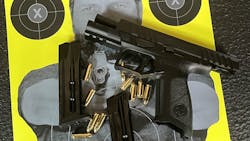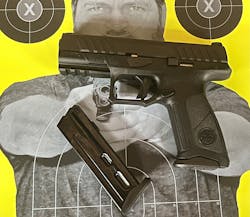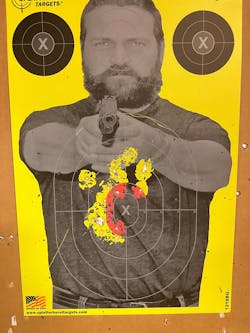Starting back in 1985, the contemporary polymer frame design handgun found its way into the law enforcement community. In the 35-plus years since then, the number of polymer frame duty-size handguns has grown noticeably. The usual design features accompanying this polymer frame base include a striker-fired action, 17-plus round capacity (in 9mm), adjustable ergonomics for the grip and more. Recently, we were asked to perform a field test and review of the Beretta APX A1 full size duty handgun. Before we get into the testing process and results, let’s take a look at the specifications as published by Beretta.
This article appeared in the March/April issue of OFFICER Magazine. Click Here to subscribe to OFFICER Magazine.
The Beretta APX A1 with an MSRP of $529 (per the Beretta USA website) is a striker-fired handgun chambered for 9mm and with a standard magazine capacity of 17 rounds. There are also 10 and 15 round variants available, most likely to keep some of those anti-gun states happy.
The barrel length of the Beretta APX A1 is published as 4.25”. A 4-4.5” barrel is becoming commonplace on a duty weapon, or a weapon intended for military and law enforcement sidearm use. Some users balk at having less than a 5” barrel in a semi-automatic pistol for duty use while others remember (fondly?) the days of a common 4” revolver and view the 4.5” barrel as more than sufficient. Accuracy testing that compares the difference between a 4” barrel and a 5” barrel in a weapon intended for duty use reveals no appreciable difference. Remembering that the average duty officer isn’t using a handgun for hostage rescue work, if there’s a difference of even one inch in grouping at standard defense distances—25 yards or less—does it matter? No, and the difference found between the Beretta APX A1 with its 4.25” barrel and the Beretta 92 A1 with its 4.9” barrel was... zero. So, the 4.25” barrel length should be accepted as sufficient for standard-duty law enforcement and military work.
Overall length of the weapon is published as 7.5” with an overall height of 5.6”. Interestingly, when you look at the width measurements you see a difference between grip width and overall width. One of the things our test team commented on was the comfortable feel of the grip. It felt natural, almost form fitted to the human hand. The overall width is published as 1.3” compared to the grip width published as 1.06”. It’s interesting just how big a difference that 0.24” can make but it is very noticeable.Does grip comfort matter? Absolutely. If you don’t believe that statement, take two handguns out to the range: one that feels marvelous in your hands and one that is slightly too big to be comfortable in your hands. Then shoot about 500 rounds through each of those weapons and experience the difference the grip width, and related grip circumference can make. If you do have larger hands, the APX A1 comes with adjustable backstraps so you can find the maximum comfort fit for your hands.
The sight radius—that distance between the front sight and the rear sight—is published at 6.1” and that’s very good for a duty size handgun. Typically, to get a sight radius near 6” you have to have a weapon with a 5” barrel. To have the 4.25” barrel but still have a 6”-plus sight radius speaks to the attention paid by the Beretta engineers when they designed this weapon. The unloaded weight of the weapon is 29 ounces, or just under two pounds, and is on par or less than the rest of today’s handgun duty weapons.
The Beretta APX A1 utilizes their chassis system wherein the trigger group is modular and is the part that is serialized for the purposes of registering a weapon with the ATF. The grip is effectively an accessory that can be purchased as an aftermarket part without having to do any transfer paperwork through an FFL. This method of design and construction allows for purchasing a single weapon—identified by the serialized trigger group—and be able to adapt it to a variety of needs by changing slide assembly and/or grip.
With all of that information in hand, the test team headed to the range with a few targets and a mix of ammo that ran the gamut from old 124g FMJ to brand new Speer Gold Dot 2 JHP. Prior to firing the weapon, we performed only the lightest of cleaning to get out any dust or lint that might have been inside the weapon (it was a test weapon after all and we weren’t the first to have fired it). We did not lubricate the rails at all prior to firing it. We should note that the APX A1 has a slide that is cut to be optics ready, but our test unit was fired using the iron sights. We did not have or mount a red-dot optic for our testing. There is also a standard picatinny rail under the dust cover, but we did not mount a light or laser unit for testing.
During all of our test firing, we experienced no malfunctions in the form of failure to feed, failure to extract or failure to eject. Every person testing the weapon had more than ten years of experience with duty sidearms and each of them was a firearms instructor. Hand sizes ranged from medium to large and virtually every person who even held the weapon commented on the comfort and ergonomics of the grip.
As the weapon was fired, the test team commented on the recontoured trigger safety and the added comfort of the trigger face. The reset is very short and the trigger pull is crispy feeling. The trigger pull weight is approximately six pounds, but it honestly doesn’t feel it. It feels like it would be between four and five pounds (based on subjective experience while firing).
Perceived recoil was commented on by all of the testing team. Recoil felt more “straight back” rather than “arcing up.” This is due to the grip design that positions the shooter’s hand higher, lowering the bore axis farther as compared to the palm of the shooter’s hand. The change in felt recoil directly correlates to the comfort of shooting and feel in the hand.
After the team had fed several hundred rounds of ammo through the weapon for the purpose of familiarity and testing functionality, we fired a few magazines for general combat accuracy testing. These groups were fired from 15 yards without a barricade or other support. It was very easy to keep all the shots inside of an eight-inch area or the “combat pie plate” that is commonly cited. With slowed intentional fire, the average five-shot group was about 1.5”- 2” at that 15-yard distance.
All-in-all, the testing team gave the weapon strong approval. Some discussion was had about suitability for off-duty carry and the size, but that point of view was easily and quickly offset by the reality that the APX A1 was designed as a DUTY weapon—not an off-duty weapon.
For more information on the Beretta APX A1, visit www.berettausa.com
This article appeared in the January/February issue of OFFICER Magazine.
About the Author
Lt. Frank Borelli (ret), Editorial Director
Editorial Director
Lt. Frank Borelli is the Editorial Director for the Officer Media Group. Frank brings 20+ years of writing and editing experience in addition to 40 years of law enforcement operations, administration and training experience to the team.
Frank has had numerous books published which are available on Amazon.com, BarnesAndNoble.com, and other major retail outlets.
If you have any comments or questions, you can contact him via email at [email protected].



